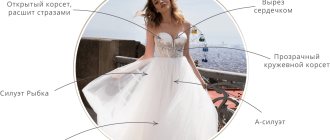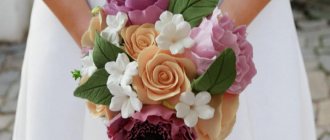Preparing for the wedding, the newlyweds strive to surprise those present at every step: from original and carefully thought-out images to an unusual choice of cars for the motorcade. It’s good that exclusive retro cars for weddings at rental locations can satisfy the most demanding tastes. Newlyweds are offered rare models of limousines, Cadillacs, domestic cars and convertibles for their wedding. Perhaps the most original retro transport is the car-carriage, about which the Svadebka.ws portal is ready to tell all the most interesting things.
B - Brichka
Britzka.
1860s. Photo: russiainphoto.ru This word is of Polish origin, it means a light four-wheeled road cart, sometimes without springs. The body of the chaise could be either open or closed: leather, wicker or wood.
It was in the britzka that the main character of Nikolai Gogol’s “Dead Souls”, Pavel Ivanovich Chichikov, traveled. His chaise was “quite beautiful, with springs,” and even with amenities: the top of the body was “closed against the rain with leather curtains with two round windows, designated for viewing road views.” It was a quite decent road carriage for such an official as Chichikov, befitting his rank, even if, as they would say today, “not a representative class.”
Perhaps this is why many Russian classics described the britzka as an extremely noisy transport. Leo Tolstoy's chaise bounced, Sholokhov's chaise rattled or rattled, and Alexander Serafimovich wrote that “an intolerably sultry ringing rattle rolled behind it.” David Burliuk, dedicating poems to a certain bird with an unbearable voice, compared it to an old broken chaise.
Advantages of a carriage car
A carriage-car for a wedding is nothing more than an ordinary car, the body of which is made in the form of a classic carriage. What is its advantage over conventional wedding transport, see below:
- Emphasizes the theme of the celebration and is guaranteed to cause a “wow” effect.
- It can accommodate a considerable number of people in its cabin, depending on the model. For example, a snow-white Chrysler wedding carriage is designed for 6 passengers, and a Dodge “carriage” is designed for 8 or 9. Thus, the newlyweds can seat not only witnesses, but also close friends or relatives in the car.
- The height of the ceilings in the cabin, equipment with modern appliances and a bar guarantee maximum comfort during the trip.
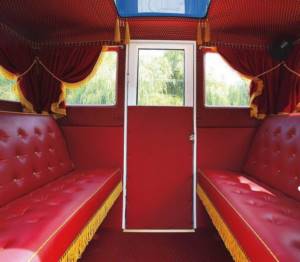
B - Cart
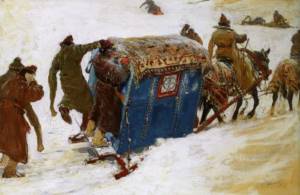
Sergey Ivanov. Boyar slaves. 1909. Collection of Rostropovich and Vishnevskaya
The term was used for a winter type of transport - a covered wagon on runners. The cart is praised for its warmth, it is comfortable, you can ride lying down - “lounging in the cart under fur blankets” (Amphitheaters). It is “filled with feather beds, pillows, etc.” (Victor Shompulev). The windows could be lined with bear fur to prevent drafts, and the inside could be lined with red cloth or even velvet.
Saltykov-Shchedrin’s children were stuffed into a cart, “like sardines in a barrel, and at the same time they were wrapped in such a way that it was difficult to breathe.” Frozen on the street, they will quickly warm up, because “in a minute we will be squeezed into a covered cart and so, sealed, we will be delivered to our destination” (“Poshekhonskaya Antiquity”).
They note how easily he walked through the snow. Boris Chicherin honestly admits: “When I, all dressed up, sat on the cart, I wanted to go and go and never get there.” Finally, “Calm, strong and light / A wonderfully well-coordinated cart,” in which Nekrasov’s wife, Princess Trubetskaya, leaves for Nekrasov. This transport was considered heavy, clumsy and lordly, old-fashioned: provincial Tatyana Larina was taken to the bride fair in a “boyar’s cart”.
Advantages of carriage-shaped cars
Carriages are distinguished by their large capacity and comfortable interior. The rich interior design is in keeping with the best traditions of luxurious vintage carriages, while being equipped with all the latest technological advances.
A young couple and guests will sit comfortably on silk or leather sofas. They have a bar with everything you need for a festive mood. The atmosphere in the cabin is regulated by climate control, which will warm you in winter and cool you in summer. A modern audio system with high sound quality will create a solemn or, conversely, relaxed, casual atmosphere. Tinted windows will hide the newlyweds and their guests from indiscreet eyes, and the high ceiling provides freedom of movement around the cabin.
Editor's choice: Children's dresses for a wedding: how to dress up a little princess
Body color and design may vary. In addition to the traditional white wedding car, the following models are available: white with gold trim, pink or red with rich inlay.
The cost of renting this vehicle is affected by the capacity of the cabin, time and place. It can vary from 3 to 5 thousand rubles per hour.
D - Dormez

Dormez (Bagration's carriage). Yuryev-Polsky Historical, Architectural and Art Museum, Yuryev-Polsky, Vladimir region. Photo: yp-muzeum.ru
The word, coming from the French “to sleep,” was used to describe large carriages in which one could stretch out. Buying foreign dorms was a source of pride. It is no coincidence that Zhukovsky writes an epigram to Chicherin: “My ancestor was famous for his control of Siberia / And I, by fate’s decree, / bought Dormez for myself.”
The cart was heavy with a solemn move: “A heavy Viennese dormez, with a postilion, six blacks, slowly rode out, rattling, from Bronnaya.”
Grigory Danilevsky. "Burnt Moscow"
D - Drovni
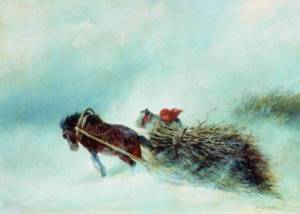
Nikolay Sverchkov. With brushwood. 1870s. GLM
Drovni are peasant sleighs for transporting goods. Writers of the 19th century themselves did not ride on similar ones, but they often put characters from the lower class in them: let’s remember Pushkin’s “the peasant, triumphant, renews the path on the logs” and “the horse carries the logs” from the song about the Christmas tree. That is why in 1918 Tsvetaeva pathetically exclaimed: “Harness the blood horses to the wood! / Drink the count’s wines from puddles!”
D - Drozhki
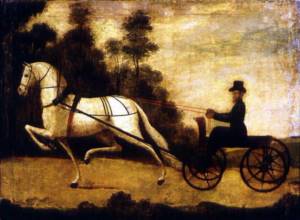
Unknown artist. A gray stallion harnessed to a droshky. 1st half of the 19th century
This saying word was used to describe a light carriage on springs, which could reach high speeds - and, naturally, tremble. Pushkin’s droshky is “daring” and takes away “young beauties”, “dandy”; for Lermontov - “dashing”. Golyadkin’s enemy rides in a “dandy droshky” in Dostoevsky’s “The Double.” The sounds they make are as follows: they rattle (Alexey Zhemuzhnikov, Konstantin Fofanov) and rattle (Ivan Nikitin).
Three questions to the “head of the transport department”
— Is the transport in the film a prop?
“We made carts and army semi-trucks,” says props designer Alexey Virchenko, specifically for filming. There is still a plant in the Bryansk region that produces them. Our sleighs are mostly rental ones - they were taken from private St. Petersburg museums. Naturally, these are not historical objects, but replicas that were created according to surviving drawings and sketches. The same goes for carriages.

— Did the crews somehow apply make-up for filming?
- Undoubtedly. For example, the family coat of arms was applied to each noble carriage. The transport was invoiced so that it would not seem like it was completely new. We aged some elements, replaced the handles of the carriages with copper or brass - they are more consistent with that time. Curtains and capes were sewn for the film so that even inside the carriage everything would look beautiful and believable.
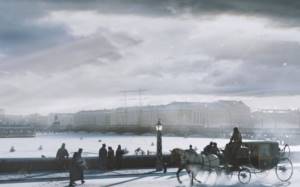
- Plausible or still reliable? Will historians get to you?
— Along with pre-production, filming “Union of Salvation” took a little over a year. This is not enough for a large-scale historical film. Therefore, of course, I had to simplify something and turn a blind eye to minor inaccuracies. For example, on some horse-drawn vehicles the chassis elements may not be completely correctly recreated. This is a compromise that had to be made to meet the deadline.
- Read what happened to the cars from our favorite films here.
Photo: Cinema Directorate, Channel One
The great-grandfathers of Solaris, Camry and Bentley - this is how they drove in the 19th century!
K - Convertible
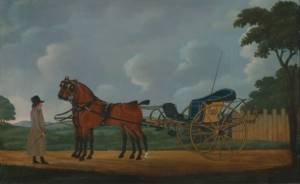
John Corney. A gentleman with a pair of his horses harnessed to a carriage. 1806. Yale
These were light two-wheeled carriages without goats - that is, for people who wanted to drive themselves. This crew was elegant. Thus, in Pisemsky’s work, a character named Elpidifor Martynych “clumsily and timidly climbed into a rather tall convertible,” whose name immediately betrays his inappropriateness in a dandy vehicle.
It was good to take girls for rides in them: “From behind the forest, a light convertible was rushing towards his village house, where Grunya, pink from the air and fast driving, was sitting, not without fear, clinging to her young friend” (Alexander Sheller-Mikhailov). It was so easy to control that even ladies took the reins.
Which carriage to choose for a wedding
When choosing a carriage as an original wedding transport, you should keep in mind the general style of the celebration being celebrated. Carriages are divided into two types:
- classic, with horses;
- and a car stylized as a vintage carriage.
Both have their pros and cons, their stylistic limitations. As for the first, it is easier to fit into various stylistic trends, it looks very romantic and picturesque, but is less comfortable and costs more due to the maintenance of horses - an integral part of such a carriage. The carriage-car is more demanding on the overall design of the wedding, on the outfits of the bride and groom, it suits a limited number of stylistic trends, but it is very comfortable and relatively cheaper.
Editor's choice: Wedding in Greece, interesting ideas with photos

K - Carriage
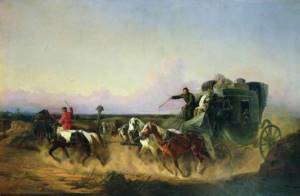
Nikolay Sverchkov. The landowner is on the way. 1855. Timing
A common word meant a closed carriage on four wheels and springs. It was used quite widely. And sometimes it became a universal means of salvation - “A carriage for me, a carriage!” (“Woe from Wit”)
Fyodor Koni had a vaudeville show “The Carriage, or They Meet You by Your Dress, You See You Off by Your Mind” about the importance of transport for prestige.
K - Kibitka
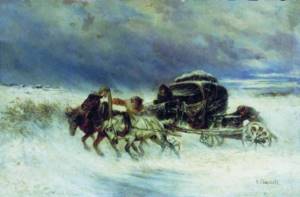
Nikolay Sverchkov. Caught in the storm. timing belt
In Russia, a word borrowed from nomads was used to call a covered wagon. Often the top had arches and could be folded back, reminiscent of a “grandmother’s cap” (Nikolai Teleshov). A good wagon means “with a spacious top and a double matting canopy” (Ivan Lazhechnikov) or “with a leather top and a tightly buttoned apron” (Pavel Melnikov-Pechersky).
It was in the shaking wagon that Radishchev rode: “Lying in the wagon, my thoughts were turned to the immeasurability of the world. I separated mentally from the earth, it seemed to me that the kibit blows were easier for me.”
Vyazemsky dedicated a whole poem to her, very angry: “And this casemate is movable, / And this torture is movable, / Which is called: wagon.” Pushkin is more cheerful: “Blowing up the fluffy reins, the daring carriage flies.” On the other hand, in his “Road Complaints” he laments: “How long will I walk in the world / Now in a carriage, now on horseback, / Now in a wagon, now in a carriage, / Now in a cart, now on foot?”
K - Stroller
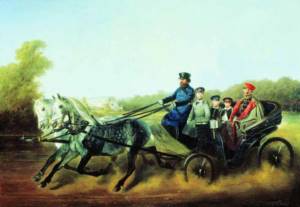
Nikolay Sverchkov. Riding in a stroller (Alexander II with children). Yaroslavl Art Museum
In Russia, “carriages” meant many types of open spring carriages. For example, the types of urban strollers were the landau and the phaeton. In Europe, on the contrary, a specific type of fashionable carriage was called a “stroller”.
The stroller became the heroine of Gogol’s story of the same name: the owner boasts that it is light as a feather, and the springs are as if “a nanny rocked you in a cradle.” In the end, it turns out that the boast is empty. Vyazemsky dedicated a poem of the same name to her: “A light carriage rushes, / And the mind easily carries with it.” A beautiful carriage is a matter of prestige: Dolly Oblonskaya and her coachman are embarrassed by their old, patched carriage during a visit to Vronsky’s village.
Lydia (looking out the window). Wait! What kind of stroller is this? Lace! Did maman really take this for me? What a beauty, what a luxury! Ay! I'll faint. This is not a stroller, this is a dream. You can choke with happiness sitting in this stroller. What's wrong with me?
Alexander Ostrovsky. "Mad Money"
It all ends with technical progress: “An elegant stroller, in an electric beater, / Elastically rustled along the highway sand” (Igor Severyanin).
L - Lando
A landau carriage that belonged to the British King William IV. Photo: boyko.ru
The carriage, named after the German city, was a four-seater with a lift-up top that turned it into a carriage at will. Zhukovsky in “A Trip to Maneuvers” tells how the roof somehow refused to open: “There, here, the landau is stubborn; / He overruled all the ladies, / Forced them to move / Without ceremony to another, / And he himself went empty.”
A beautiful foreign word denoted a fashionable form of transport, a must for a person from society. The hero of Mamin-Sibiryak needs a landau in order to “show them all that I can drive like the rest of them.”
From Grigorovich we read: “How many expenses, my God, how many expenses! We had to hire new horses and exchange our carriage for a landau; people of a certain position are embarrassed to show themselves to music in the evenings; that’s how it is in Peterhof” (“City and Village”).
Types of cars for weddings
Modern wedding processions consist of the most popular and popular car brands among young people. This is not only the well-known Mercedes. Holding a wedding in retro style requires the use of other cars:
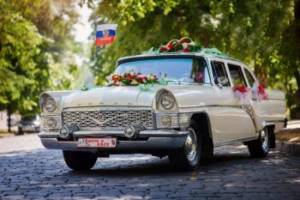
- "Volga";
- "Gull";
- "Victory".
If we talk about foreign cars, the most popular are:
- Bentley;
- "Ford";
- "Mercedes".
It is important that these are cars produced back in the 60s.
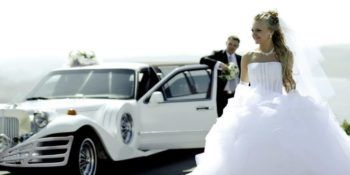
When contacting a specialized company, the bride and groom can study numerous photos showing various cars. Such a photograph will help young people make the right choice.
Here you can make sure that the car will be driven by an experienced, qualified driver, whose appearance corresponds to the degree of solemnity of the moment.
Limousine
One of the most popular cars used to organize a wedding procession. It is not always necessary to decorate such a car. Rings, satin ribbons, a bouquet of fresh or artificial flowers are enough. A limousine is a luxurious car that emphasizes the status of the bride.
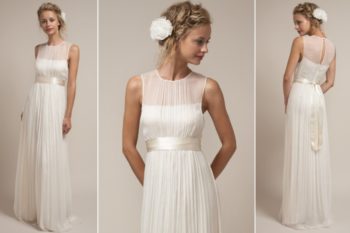
An elegant, luxurious car, inside which the newlyweds will find absolute comfort. Regardless of the color of the car body, its decoration consists mostly of fresh flowers. Such transport proves the worth of the young people, the class and level of the event.
Such a vehicle leads the cortege at a traditional classic European wedding. When deciding to choose a limousine, you should pay attention to the length of its body. In a small but densely populated city with busy traffic, it will be quite difficult to turn around in small courtyards or on narrow streets.
Therefore, the limousine is recognized as a car for wedding processions passing through the wide streets of large cities.
Horse carriage and auto carriage
A horse-drawn carriage is the dream come true for many brides. After all, all the girls once dreamed of a prince who would come riding on a white horse and take away his beloved in a beautiful carriage.
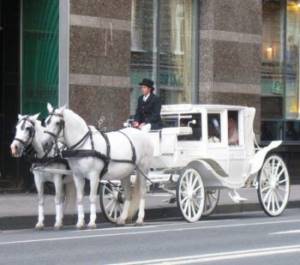
The groom can make an original surprise for the bride by renting a carriage with horses instead of a modern car. A more modern option is an autocart. Originally decorated and unique in its attractiveness, the carriage will be the ideal vehicle for transporting the newlyweds at a medieval-style wedding.
The most important decoration of such transport as a carriage is a horse, so even the most advanced brides and grooms enjoy a carriage driven by a horse tandem.
A live horse has its own charm, and it is she who is able to give the holiday the features of a real fairy tale. You can decorate such a cortege with fresh flowers.
Retro car
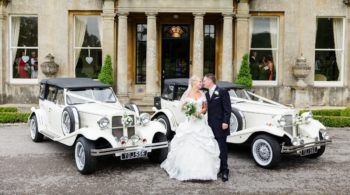
A wedding cortege in Provence or retro style consists of cars headed by a strange car.
A black or white vintage car seems to take young people on a journey through time.
The best option is a convertible. A car with a convertible top will emphasize the style of the wedding and make the entire procession original.
Modern car
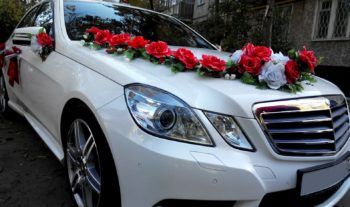
The bride and groom who decide to celebrate their wedding without deviating from modern traditions and rules use jeeps and sedans. These are foreign cars or domestic cars of the latest generation. They are comfortable and cozy.
The cabin has all the conditions for a comfortable trip.
S - Sani
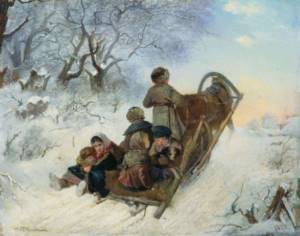
Ivan Pelevin. Children in a sleigh. 1870. Nizhny Tagil Museum of Fine Arts, Nizhny Tagil, Sverdlovsk region
Another means of transportation that has been written into poetry for a long time. “And having split the shafts, the sleigh is waiting / When they will be harnessed” (Zhukovsky); “Towards the city of Ryazan / Three sleighs are rolling, / The sleigh is falling apart / The arcs are painted” (Mei). Unlike the sledges, you can see not only peasants in the sleighs. The nobles own their own sleighs and ride in them, lying down comfortably and wrapped in warm blankets and blankets.
Pleshcheev in “Winter Skating” and other authors cover them with a carpet. In Gogol's "Marriage" the dowry decoration includes a droshky and "a pair of sleighs with carvings, under a large carpet and under a small one." Nikolai Teleshov mentions a sleigh “with a carpet back and a soft seat.” The saying “Don’t get in your own sleigh” is widely used.
Classic carriage
There are many types of classic carriages, thanks to which this romantic vehicle will fit organically and even become an integral part of wedding celebrations in various stylistic directions:
- in the classic;
- in Slavic;
- in rustic;
- in Greek;
- in vintage;
- in a fabulous
In accordance with this, newlyweds, for example, can choose a double open carriage or phaeton for a wedding in the lap of nature. Such transport goes well with wedding dresses in the style of boho, rustic, country, Provence, etc. Weddings in the now very popular Russian or Ukrainian styles are difficult to imagine without riding in a troika. For a vintage or fairytale wedding, choose luxurious carriages a la Cinderella, decorated with gilded inlay and velvet or satin upholstery.
You can use a carriage as a means of transportation not only in the warm season, but also in winter. In this case, the young couple is offered a luxury carriage, which is equipped with a heating system.
The cost of such pleasure varies depending on whether the carriage is covered or open, how many horses are harnessed to it, and how many service personnel are involved (coachman, pages).
Editor's choice: Wedding on Valentine's Day: an unforgettable holiday, photo review
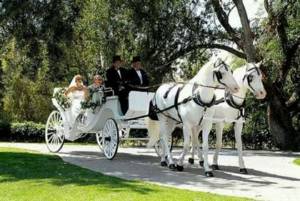
T - Tarantas
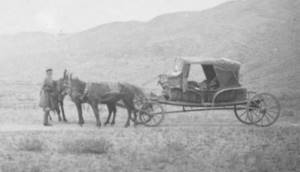
Tarantas. 1880s. National Library of Congress
Tarantas was a special covered carriage with a long longitudinal frame that reduced shaking on a long journey. Often it is shabby and rattling (Sergei Solovyov), and waddles (Ivan Surikov). In Sollogub's story "Tarantas", the main character makes a journey across Russia - of course, a satirical one, and the rumble ultimately turns into an allegory.
“But what a tarantass, what an amazing invention of the human mind!.. Imagine two long poles, two parallel clubs, immeasurable and endless; It’s as if a huge basket, rounded on the sides like a gigantic ball, has been accidentally thrown in the middle of them.”
Vladimir Sollogub. "Tarantas"
But if Bryusov or Blok’s “tarantas creaks,” then this is already a common noun.
What types of carriages are there?
Open carriage
For the warm season, a carriage with horses is suitable. For weddings in the style of the 18th and 19th centuries, you can order an open carriage. The bride and groom will look very impressive in it. What could be more romantic than moving around the city with your loved one in a beautifully decorated carriage and team?
But we must remember that incredibly beautiful open carriages will be a losing option for a winter wedding. Newlyweds shivering from the cold and the bride's makeup running from the snow are controversial decorations for the holiday.
T - Cart
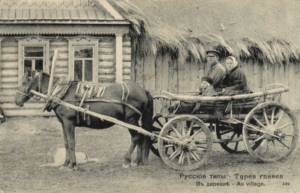
Cart. Postcard. Photo: spb.aif.ru
If you believe our poets, the cart knocks as it moves (Zhukovsky, Pushkin, Ogarev), rattles (Fet, Ivan Surikov) and “creaks” (Nekrasov), especially if it is “unlubricated,” which often happened. Her walk is lazy, calm (Ivan Nikitin). In Pushkin, the movement of the cart becomes an allegory of existence (“The Cart of Life”).
Nekrasov’s passenger is the wife of the Decembrist Maria Volkonskaya: “...At first / The cart occupied me, / But soon then, neither alive nor dead, / I recognized the charm of the cart.”
T - Troika
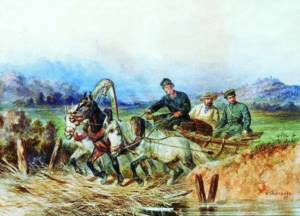
Nikolay Sverchkov. Troika. 1865. Tomsk Regional Art Museum
This is not a type of cart, but a method of harnessing - three horses, with the central one (root horse) looking straight, and the side ones (drawn horses) beautifully bending their heads to the side. In winter, sleighs were harnessed by three people, and wheeled vehicles in summer. A specifically Russian invention became a national symbol, which was facilitated by Gogol’s glorification of the bird-three - “Rus, where are you rushing?” ("Dead Souls").
Troika is perhaps the leader in inspiring poets and composers. Here are Pushkin’s “Winter Road”, and Vyazemsky’s “The troika is rushing, the troika is galloping”, and Nekrasov’s “Why are you greedily looking at the road...”, as well as the “daring troika” with “a bell - a gift from Valdai” by Glinka... It’s impossible to list them all. The poets liked her dashingness and speed - she is “greyhound”, “brisk”, “dashing”, “crazy”, “mad”; the coachman on it is “unhinged.”



